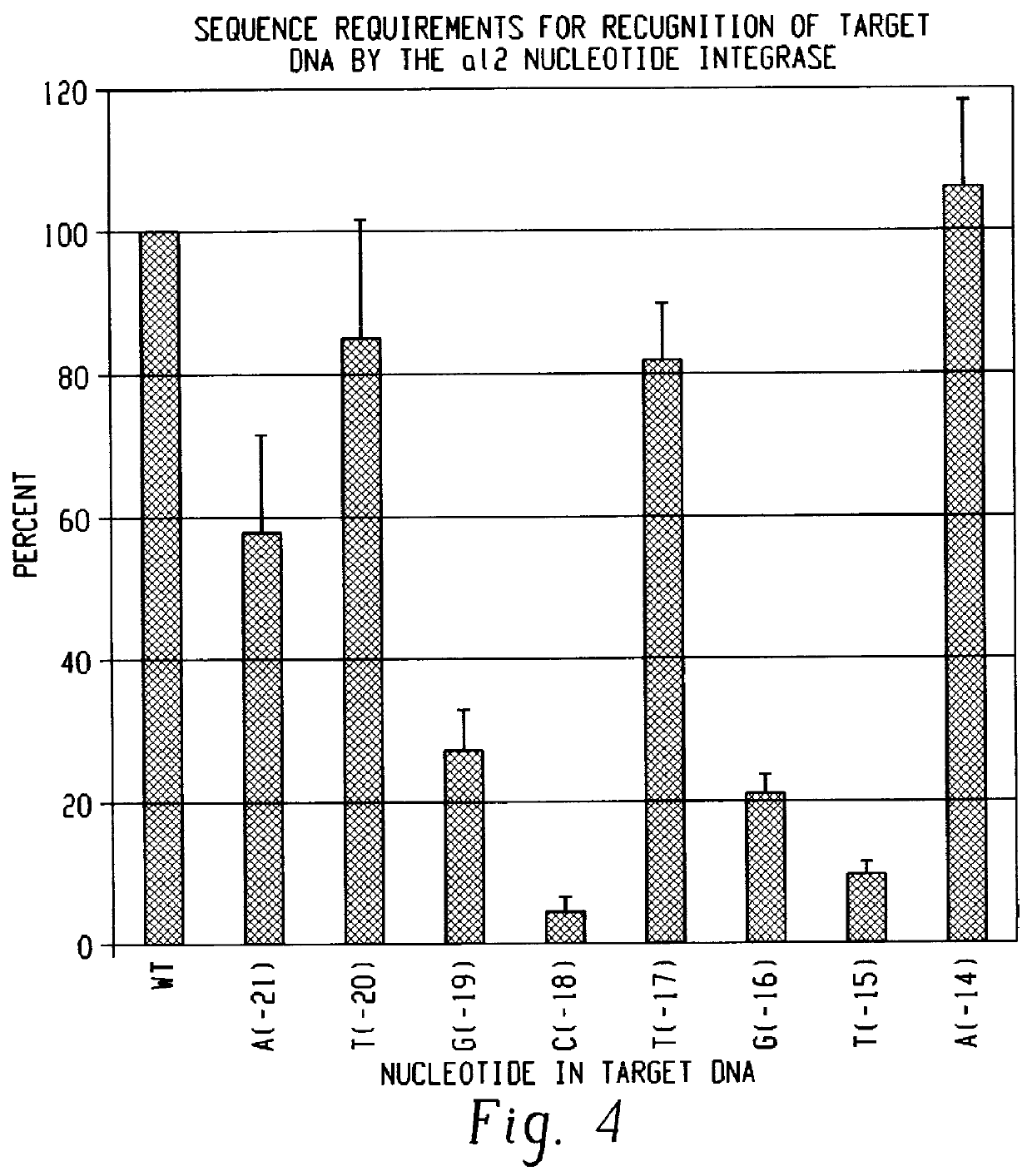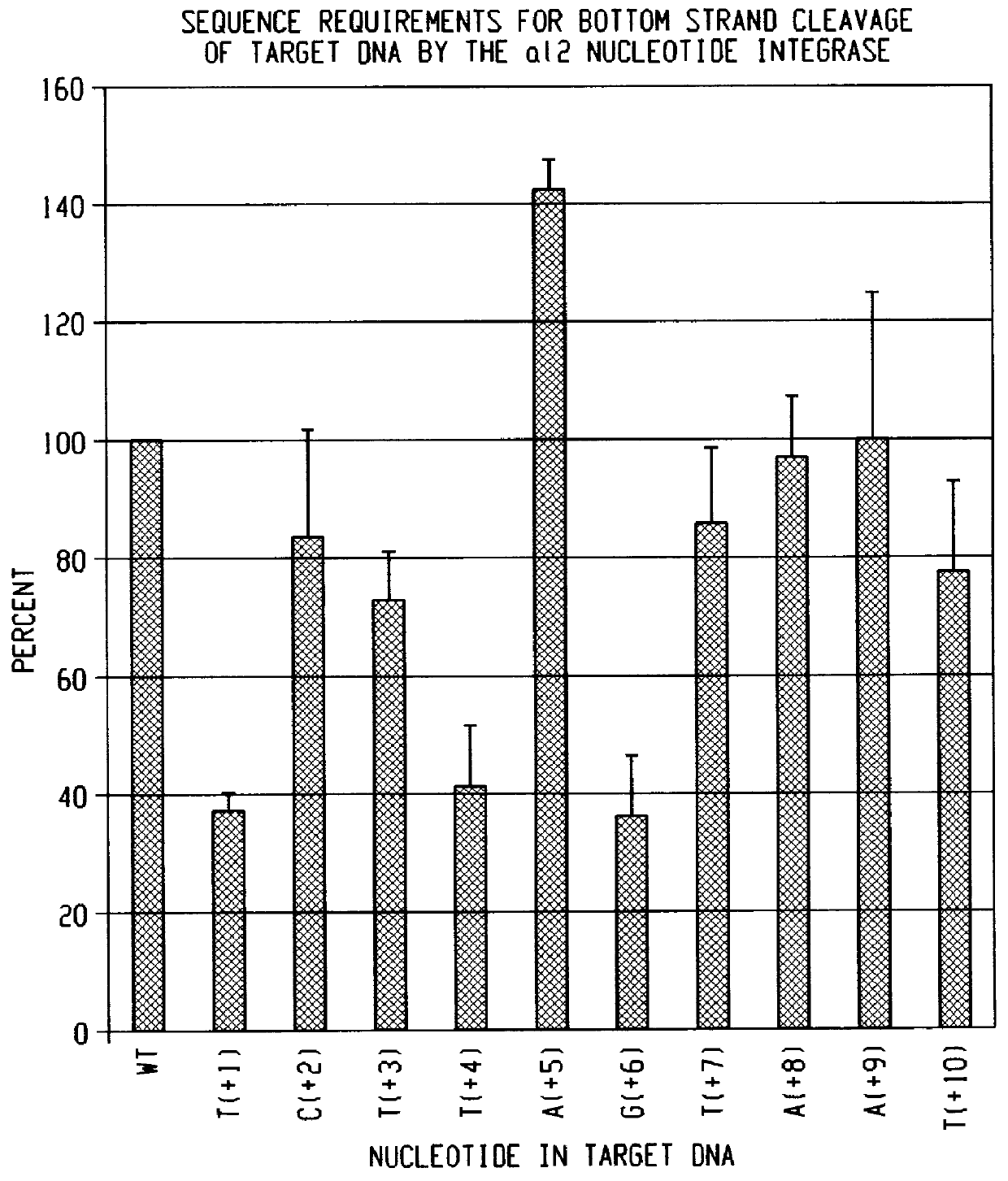Methods for cleaving DNA with nucleotide integrases
a nucleotide integrase and dna technology, applied in the field of methods for cleaving dna with nucleotide integrases, can solve the problems of non-functional dna of the substrate, ribozymes that have not been particularly useful for cleaving single-stranded dna substrates or double-stranded dna substrates, and ribozymes that have limited use in systems containing
- Summary
- Abstract
- Description
- Claims
- Application Information
AI Technical Summary
Problems solved by technology
Method used
Image
Examples
example 1
Cleaving a Double-Stranded DNA Substrate with a Nucleotide Integrase Comprising a Wild-type aI2 Intron RNA and a Wild-type aI2-Encoded Protein
0.025 O.D..sub.260 units of the RNP particles of formulation 1 were reacted with a DNA substrate consisting of yeast mitochondrial COX1 exons 2 and 3 (E2E3) and comprising the WT sequence shown in FIG. 3. The reaction was conducted at 37.degree. C. in a buffer containing 100 mM KCl, 20 mM MgCl.sub.2 at pH7.5. One portion of the cleavage products was denatured with glyoxal and analyzed in a 1% agarose gel to determine the extent of cleavage of the top strand or sense strand of the DNA substrate at the E2 / E3 junction. Another portion of the nucleic acid cleavage products was analyzed in a denaturing 6% polyacrylamide gel to determine the extent of cleavage of both strands of the double stranded DNA substrate. The gels were dried and autoradiographed or quantitated by phosphorimaging with a Molecular Dynamics Phosphorimager 445.
The results indica...
example 2
Cleaving a Double-stranded DNA substrate with the Reconstituted RNP Particle Preparation of Formulation 12
The reconstituted RNP particle preparation of formulation 12 was reacted with 250 fmoles (300,000 cpm) of the 142 base pair DNA substrates generated from pE2E3 and which were 5' end-labeled on either the sense strand or the antisense strand for 20 minutes at 37.degree. C. To verify cleavage of both strands of the substrate, the reaction products were extracted with phenol-CIA in the presence of 0.3 M NaOAc and 2 .mu.g single-stranded salmon sperm DNA followed by precipitation with ethanol. Reactions products were analyzed in a 6% polyacrylamide / 8 M urea gel. The results indicated that the reconstituted particle preparation cleaves both strands of a double-stranded DNA substrate which contains the wild-type sequence shown in FIG. 4. Similar results, i.e. cleavage of both strands, were obtained when the 5' end labeled substrates were incubated with the RNP particle preparation of ...
example 3
Cleaving Double-stranded DNA Substrates with a Nucleotide Integrase Comprising a Modified aI2 Intron RNA and an aI2-Encoded Protein
0.025 O.D..sub.260, units of the RNP particles of formulation 13 in which the EBS1 of the aI2 group II intron RNA was changed to the EBS1 sequence of the all intron RNA was reacted with the wt DNA substrate of FIG. 3 and with a derivative thereof in which the nucleotides at position -1 to -6 were simultaneously changed to 5'TTAATG, which is the IBS1 sequence of the wt sequence for the aI1 nucleotide integrase. The reactions were conducted and the cleavage products analyzed as described in example 1. The results indicated that an aI2 nucleotide integrase comprising a group II intron RNA with a modified EBS1 was not able to cleave a substrate with the wt sequence but was able to cleave a substrate in which the nucleotides at position -1 to -6 were complementary to the modified EBS1.
PUM
| Property | Measurement | Unit |
|---|---|---|
| pH | aaaaa | aaaaa |
| pH | aaaaa | aaaaa |
| pH | aaaaa | aaaaa |
Abstract
Description
Claims
Application Information
 Login to View More
Login to View More - R&D
- Intellectual Property
- Life Sciences
- Materials
- Tech Scout
- Unparalleled Data Quality
- Higher Quality Content
- 60% Fewer Hallucinations
Browse by: Latest US Patents, China's latest patents, Technical Efficacy Thesaurus, Application Domain, Technology Topic, Popular Technical Reports.
© 2025 PatSnap. All rights reserved.Legal|Privacy policy|Modern Slavery Act Transparency Statement|Sitemap|About US| Contact US: help@patsnap.com



